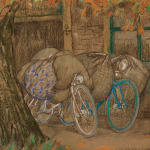Leo Gestel (1881-1941)
Leo Gestel trained at the Rijksnormaalschool of Amsterdam, where he graduated in 1903. The first years after school he worked as an illustrator of books and designed advertising leaflets. During his school period he became friends with Jan Sluijters (1881-1957), and together they left for Paris in 1904. Inspired by his trips to Paris, Gestel developed his own cubist style, combining the static cubism of Picasso and Braque with the dynamics of Italian Futurism. Together with Mondrian, Gestel played an important role in Dutch modernism in the early twentieth century while both kept elements of nature. A large part of Gestel’s work, around 400 paintings, were destroyed in his Bergen studio during a fire in in 1929. After the incident, Gestel moved to Blaricum, where he remained until his death on 26 November 1941.[1]
At the end of the summer of 1913, Gestel did not want to stop painting outdoors, and through Jan Toorop he came into contact with the Belgian artist William Degouve de Nuncques, who recommended Mallorca as an artist's destination. Soon after his return from the sunny island, World War I began and the contrast between Spain and the motherland could not have been bigger. The displacement and hunger caused by the German occupation of Belgium led to the exile of its citizens to the neutral Netherlands. Drawn to the plight of the refugees wandering up north, Gestel felt compelled to render the effects of the war on its population. By October 10, 1914, as Antwerp capitulated, over one million civilians fled across the border to the Netherlands to escape the Germans.
Gestel went to Roosendaal, a Dutch town close to the border to record the Belgium refugees in sketchbooks, source material for poignant drawings executed in the studio Amsterdam. They were exhibited in a traveling exhibition with part of the proceeds designated to Belgian Relief, a predominantly American organization led by Herbert Hoover to supply food to the occupied territories. Praised for his depiction of the human suffering, Gestel's drawings sold extremely well, persuading him to make additional drawings during the exhibition.
[1] A.B. Loosjes-Terpstra, Moderne Kunst in Nederland 1900-1914, Utrecht 1959, p. 142,; W.v.d.Pluym, Leo Gestel, Amsterdam 1936, p. 19; A. Venema, Nederlandse Schilders in Parijs, 1980, p. 209 (ill. the version from 1912.



